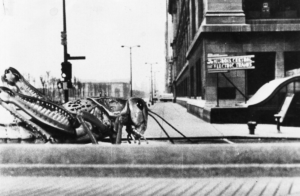“These days they blame the atom for everything!”
Bert I. Gordon’s Beginning of the End lives up to just about every cliché and stereotype of ‘50s science fiction. It features oversized arthropods whose growth is galvanised by radiation; conventional weaponry is almost useless against the beasts; and lengthy monologues abound from a scientist type, who explains scientific theories and processes to the other characters. It’s also a light and easy watch for creature-feature fans.
The town of Ludlow, Illinois is demolished overnight with no survivors. After reporter Audrey Aimes (Peggie Castle) asserts her suspicions to the military brass, she comes across entomologist Ed Wainwright (Peter Graves). Ed’s been experimenting on fruit and vegetables using radioactive isotopes, growing enormous strawberries and tomatoes. After a close encounter with a giant grasshopper at a wrecked warehouse, Ed theorises that these mini-beasts must have fed on the radioactive fruit and become not-so-mini-beasts in the process…
Beginning of the End fits neatly into the decade’s atomic monster fiction. It perfectly aligns with Vivian Sobchack’s description of the science-fiction film, in that it deals with society in conflict with some alien other; as opposed to the individual in conflict with society (or some extension of himself) as in the horror film. Indeed, after the shock at the grasshoppers’ existence, the emotional focus lies not in why these beasts act as they do, but rather what they will do and the horror of how they will do it. Unlike the monsters of the horror film, these grasshoppers are depersonalised. Moreover, there isn’t a congruence of the two genres that would allow for a moral exploration of internal strife, as with Lee Van Cleef in It Conquered the World (1956), so the potential for commentary on responsible use of radiation is nowhere to be found. That an atomic bomb is suggested to take care of the grasshoppers, despite radiation stirring their growth in the first place, demonstrates this lack of due consideration.
The overall plot is thin, which raises the question of why the first few scenes drag as slowly as they do. The film makes an earnest attempt at character backstory, with Audrey recalling her background as a war zone photographer, but these bits are rather hampered by some melodramatic dialogue. An army chap says to her, “you must be used to it by now” (it being the spectacle of a destroyed town) to which she responds, “Captain, there’s some things you never get used to.”

Nevertheless, the film begins to hit its mark once the grasshoppers make their monstrous appearance. Of note is a great sequence in which the irritable insects swarm the last line of defence outside Chicago. With a small budget, Bert I. Gordon cleverly arranges stock footage of military combat to complement his composites of the grasshoppers. Overall, the special effects (handled by Gordon himself) are quite good. Despite a few shots that don’t convince, the film delivers on its trailer’s ballyhoo of promising to show giant monsters invading a city.
That’s certainly something you can count on for all of Bert I. Gordon’s many creature features – you definitely see your money’s worth of the monster. Whether it’s the fearsome cyclops of The Cyclops (1957), or the aggravated arachnid of Earth vs the Spider (1958), Gordon’s ‘50s output placed its beasts front-and-centre in ways that several contemporaries simply didn’t (the collective screen time of the titular invaders in 1957’s Invasion of the Saucer Men is near two minutes in a sixty-minute feature).
In 1984’s Gremlins, the poster for Beginning of the End can be seen in the background of Billy’s bedroom. It’s clear how this picture had a profound effect on Joe Dante, as his marvellous Matinee (1993) proves. Matinee’s movie-within-a-movie, Mant!, takes many cues from Beginning of the End. Dante lovingly recreates the awkward, expository lines explaining scientific theories that are liberally peppered throughout Gordon’s film. Among Beginning of the End’s finest are when Ed Wainwright explains photosynthesis, and when Ed explains the plan of attack against the grasshoppers in the climax.
Beginning of the End may be thin on plot but it’s big on its beasties. The film can be appreciated amongst its contemporaries for what it adds to the canon of atomic bomb cinema, even if its own script is without heavy introspection. The film’s trailer promises us that we’ll see giant monsters invade a city, and giant monsters invading a city I did see. Bert I. Gordon’s monstrous filmography is as fun as it is fascinating, and his earliest efforts like this and The Cyclops are interesting examples of his first steps. For fans of monster cinema, I recommend it.

